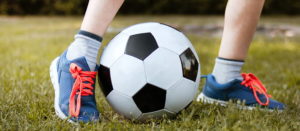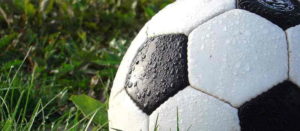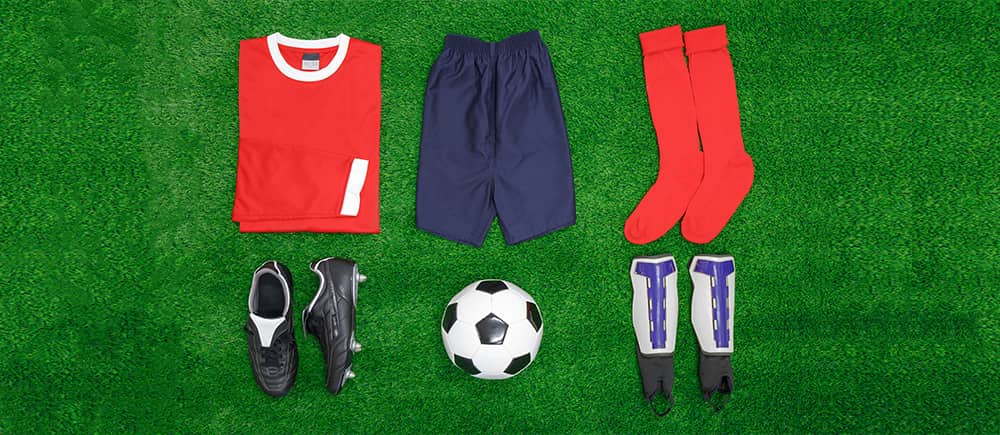Soccer is played by people all around the world at different levels, ranging from recreational to professional. Each level has different requirements when it comes to what to wear to a soccer game.
Here is a list of the basic items to wear when playing soccer:
- Jersey
- Shorts
- Soccer cleats
- Shin guards
- Soccer socks
- Gloves (for goalkeepers)
These basic soccer items can be used across all levels when playing soccer. In addition to these items, there are also a number of extra items that players can wear to a soccer game and pack in their soccer bag.
Let’s take a closer look at each soccer item and understand why players may need these when playing soccer.
Soccer Jersey
When playing recreational or official club soccer, players should wear a soccer jersey or t-shirt in the team colors. This is so the players, officials and spectators can easily identify players on each team. Also, a number can be found on the back of a soccer jersey to identify players in a team.
Most soccer jerseys are generally short-sleeved, however long-sleeved jerseys are also acceptable and are predominantly used in cold weather. Many teams these days, however, use short-sleeved jerseys instead, as players can wear a long-sleeved compression shirt under their jersey to keep them warm in cold and wet weather.
A goalkeeper is also required to wear a soccer jersey, however, their jersey must be a different color to those in the team. This is so they are easily identifiable on the field amongst the on-field players.
Soccer Shorts
Soccer shorts are required to be worn by players when playing soccer and it’s compulsory for all on-field players to wear the same colored team shorts.
Soccer shorts are generally loose and made from a lightweight material, allowing players to run freely and maneuver without restraint. Some teams have numbers on the front of their shorts, to further assist with identifying players in a team.
Players can also opt to wear compression shorts under their soccer shorts. These are required to be the same color as their soccer shorts and are generally worn in cold weather to help keep a player warm during the game.
For goalkeepers, they can wear different colored soccer shorts to those in the team or opt to wear pants instead of shorts. Most goalkeepers wear shorts that have padding in them, however, some goalkeepers wear padded long pants in colder weather and for even more protection.
Soccer cleats
Soccer cleats also referred to as soccer boots, are the most important item a player can wear when playing soccer. There are a variety of soccer cleats available for players these days, with many different brands, colors, and materials to choose from.
Soccer cleats are also made specifically for different playing conditions, such as wet weather surfaces and firm grounds.
Soccer cleats made for wet weather playing conditions have long metal or screw-in studs on the sole. These longer studs prevent the player from slipping on wet and soft playing surfaces, providing traction when running, stopping and changing direction.
In contrast, firm ground cleats have a molded sole or shorter rubber studs. This provides players with traction on hard and dry playing surfaces.
There are also some soccer cleats that have a combination of both longer and shorter studs. These cleats can cater for playing on all playing surfaces and in all weather conditions. Although these may be convenient, most players opt to have two separate pairs of cleats to cater for wet weather and for dry conditions.
Shin Guards
Shin guards, also referred to as shin pads, are important for players to wear to protect their shins and ankles when playing soccer. It is compulsory for players to wear shin guards during an official match, although it’s encouraged that players even at a recreational level should also wear shin guards to reduce the chance of injury.
There are 2 types of shin guards players can choose to wear; slip-in shin guards or ankle protective shin guards:
- Slip-in shin guards
These are placed on the players’ shin and can be held in place by a shin guard sleeve, strap or purely by the soccer sock. These types of shin guards are generally very light, comfortable and protect the shin area of a player. - Ankle protective shin guards
These are a bulkier option, providing protection to a player’s ankle as well as the shin. Padding is found around the ankle to provide protection from kicks and knocks to the ankles. These shin guards are generally secured in place by a Velcro strap at the top of the shin, as well as an elastic strap under the foot.
What are shin guards used for in soccer?
Check out this post which covers everything you need to know about shin guards.
Read moreSoccer Socks
Soccer socks are worn over shin guards to help keep the shin guards in place and to provide further protection to the player.
Socks should be pulled up just below the knee and must be the same color as fellow teammates.
Most soccer socks these days are tighter around the ankles. This is to help keep the shin guards in place and ensure they don’t fall down past the ankle.
Goalkeeper gloves
Goalkeepers are the only players allowed to use their hands during a soccer match. Gloves are worn by goalkeepers to help with gripping the ball when saving a shot, throwing, punching and picking up the ball.
Goalkeeper gloves are padded to provide protection to the hands and fingers, preventing injury.
Extra items to take to a soccer game
In addition to the general items to wear when playing soccer, here are some additional items worth considering to take to a soccer game:
- Soccer bag (large enough to carry all soccer clothes and equipment)
- Shin guard stays or electrical tape (to hold shin-guards in place)
- Compression clothes (long-sleeve t-shirt and shorts to wear under soccer uniform)
- Warm-up gear (t-shirt, jacket, and pants)
- Cap (for goalkeepers to prevent glare from the sun)
- Band-Aids and Vaseline (to assist in preventing blisters)
- Body gel or cream (for pain relief and warming up muscles)
- Strapping tape (useful for strapping ankles and knees)
- Water bottle and snacks (for refueling the body before, during and after the game)
- Sunscreen
- Plastic bags (for dirty cleats and clothes)
- Towel (for drying off or showering)
Below are some suggestions on what to wear for recreational soccer and also what is generally required for playing club soccer.
What to wear for recreational soccer?
Although there are no rules when it comes to what to wear when playing recreational soccer, it’s a good idea to still prepare some general items to take to a match.
Here are some basic items to consider wearing when playing recreational soccer:
- T-shirt / Jersey (short-sleeved or long-sleeved depending on weather conditions)
- Shorts
- Cleats
- Shin guards (optional)
- Soccer socks (to be worn if wearing shin guards)
- Gloves (for goalkeepers)
Knowing the weather conditions beforehand can help plan what to wear and bring to a soccer match. If it’s going to be a warm day, it would be wise to play in a t-shirt and shorts.
Also, it’s always important to bring a water bottle to the soccer, regardless of the weather conditions to stay hydrated. This is even more of an importance in warmer weather conditions to prevent dehydration.
In cool and wet weather conditions, it would be worth considering to play in a long sleeve t-shirt to stay warm. Also bringing a spare pair of clothes to change into after the game could be a good idea, especially if it’s expected to rain.
For recreational soccer, it’s common to only own one pair of cleats to play soccer. Soccer cleats can be expensive to buy, especially for people who are only interested in playing for fun. In this case, choosing to purchase one pair of multi-purpose cleats designed for all weather conditions could be a good option.
Finding multi-purpose weather cleats may be difficult, therefore investing instead in a pair of firm ground cleats to use an all-rounder option is a good idea. Firm-ground cleats can be worn in most weather conditions, including wet surfaces, although traction could become an issue.
This would still allow a player to get around on the field and play, unlike wet weather cleats, which are purely designed for wet weather surfaces, making it very difficult to play on dry and firm surfaces.
Shin guards are optional when playing recreationally, although wearing shin guards can prevent injury and should be considered when playing recreationally. Shin guards are also quite inexpensive, so it’s not a big investment for the recreational player.
What do soccer players wear to an official club match?
Official club soccer has strict dress requirements, so it’s important to follow the rules of the league when considering what to wear when playing soccer.
Players should be well prepared when playing club soccer. Generally, a player would bring along a soccer bag that includes both essential and non-essential items.
Here are some important items to consider wearing when playing club soccer:
- T-shirt / Jersey
- Long-sleeved compression top (to wear underneath a jersey for cold and wet conditions)
- Shorts
- Compression shorts (to wear underneath short for cold and wet conditions)
- Cleats/boots (2 pairs – firm ground and wet weather cleats)
- Shin guards
- Soccer socks
- Gloves (for goalkeepers)
- Cap (for goalkeepers to prevent glare from the sun)
- Warm-up gear (t-shirt, jacket, and pants)
Soccer clubs generally provide players with a soccer uniform to wear on match days. This generally consists of a team jersey, along with shorts and socks.
Players also should have 2 pairs of soccer cleats on hand, with each pair catering specifically for different weather conditions. This provides the player with options when deciding to use which cleats to wear, as cleats are designed for different weather conditions.
Shin guards are required to be worn in club soccer, so it’s important that players wear good quality shin guards that are comfortable and lightweight. There is the option to choose between slip-in shin guards or ankle protective shin guards.
Conclusion
Years ago, players wore lace-up shirts, long shorts, and heavy boots. This has changed dramatically over the years. Today players are much faster and can move around easier thanks to streamlined and lightweight gear.
There are many options to consider when buying adult or youth soccer gear. The main thing to consider is whether you are playing recreational soccer or official club soccer.
For recreational soccer, it’s possible to get away with wearing the basic essential soccer gear. On the other hand, for official club soccer, it’s worth having a wider variety of soccer gear available.
Buying adult or youth soccer gear is much easier these days, with the ability to buy online or at your local sporting store.
Share
Related posts:
- What is the best age to start soccer?
 A guide to understanding the best age for kids to start playing soccer and how to go about getting kids involved in the playing the sport, ranging from…Read more.
A guide to understanding the best age for kids to start playing soccer and how to go about getting kids involved in the playing the sport, ranging from…Read more. - Why are soccer balls black and white?
 Black and white soccer balls were first used at the 1970 World Cup, with the Adidas ‘Telstar’ developed to be seen more clearly on… Read more.
Black and white soccer balls were first used at the 1970 World Cup, with the Adidas ‘Telstar’ developed to be seen more clearly on… Read more. - What are shin guards used for in soccer?
 Shin guards are worn in soccer to provide protection to the shin and lower leg area of a player, helping to prevent lower leg injuries… Read more.
Shin guards are worn in soccer to provide protection to the shin and lower leg area of a player, helping to prevent lower leg injuries… Read more.
ABOUT ME
Hi, I’m Steve. I started playing soccer at the age of 4 at my local soccer club. I developed a passion for the game at an early age that saw me go on to play soccer for 29 years. Soccer is a big part of my life and I want to share with you what I’ve learned along the way. Happy exploring!

